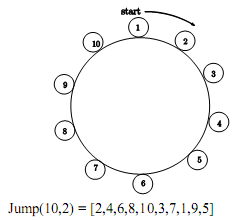1066 . Jump
Description
Integers 1,2,3, …, n are placed on a circle in the increasing order as in the following figure. We want to
construct a sequence from these numbers on a circle. Starting with the number 1, we continually go round by
picking out each k-th number and send to a sequence queue until all numbers on the circle are exhausted. This
linearly arranged numbers in the queue are called Jump(n,k) sequence where 1 ≤ n, k.
Let us compute Jump(10,2) sequence. The first 5 picked numbers are 2, 4, 6, 8, 10 as shown in the following
figure. And 3, 7, 1, 9 and 5 will follow. So we get Jump(10,2) = [2,4,6,8,10,3,7,1,9,5]. In a similar way,
we can get easily Jump(13,3) = [3,6,9,12,2,7,11,4,10,5,1,8,13], Jump(13,10) = [10,7,5,4,6,9,13,8,3,12,1,11,2]
and Jump(10, 19)=[9,10,3,8,1,6,4,5,7,2].

You write a program to print out the last three numbers of Jump(n,k) for n, k given. For example suppose that
n=10, k=2, then you should print 1, 9 and 5 on the output file. Note that Jump(1,k)=[1].
Input Format
Your program is to read the input from standard input. The input consists of T test cases. The number of test cases
T is given in the first line of the input. Each test case starts with a line containing two integers n and k,
where 5<=n<=500000 and 2<=k<=500000
Output Format
Your program is to write to standard output. Print the last three numbers of Jump(n,k) in the order of the last
third, second and the last first. The following shows sample input and output for three test cases.
Sample Input 1
3 10 2 13 10 30000 54321
Sample Output 1
1 9 5 1 11 2 10775 17638 23432
Hints
Problem Source
Migrated from old NTUJ.
2009Seoul
Subtasks
| No. | Testdata Range | Score |
|---|